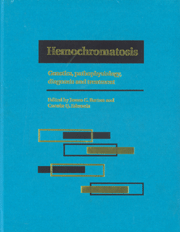Book contents
- Frontmatter
- Contents
- List of contributors
- Foreword
- Part I Introduction to hemochromatosis
- Part II Genetics of hemochromatosis
- Part III Metal absorption and metabolism in hemochromatosis
- 10 Intestinal iron-binding proteins
- 11 Intestinal iron absorption and hemochromatosis
- 12 The absorption and metabolism of non-ferrous metals in hemochromatosis
- 13 Ferritin metabolism in hemochromatosis
- 14 Hepatic iron metabolism in hemochromatosis
- 15 Extra-hepatic iron metabolism in hemochromatosis
- 16 Mathematical models of metal metabolism in hemochromatosis
- 17 Expression of iron overload in hemochromatosis
- Part IV Diagnostic techniques for iron overload
- Part V Complications of iron overload
- Part VI Therapy of hemochromatosis and iron overload
- Part VII Infections and immunity in hemochromatosis
- Part VIII Hemochromatosis heterozygotes
- Part IX Relationship of hemochromatosis to other disorders
- Part X Animal models of hemochromatosis and iron overload
- Part XI Screening for hemochromatosis
- Part XII Hemochromatosis: societal and ethical issues
- Part XIII Final issues
- Index
16 - Mathematical models of metal metabolism in hemochromatosis
from Part III - Metal absorption and metabolism in hemochromatosis
Published online by Cambridge University Press: 05 August 2011
- Frontmatter
- Contents
- List of contributors
- Foreword
- Part I Introduction to hemochromatosis
- Part II Genetics of hemochromatosis
- Part III Metal absorption and metabolism in hemochromatosis
- 10 Intestinal iron-binding proteins
- 11 Intestinal iron absorption and hemochromatosis
- 12 The absorption and metabolism of non-ferrous metals in hemochromatosis
- 13 Ferritin metabolism in hemochromatosis
- 14 Hepatic iron metabolism in hemochromatosis
- 15 Extra-hepatic iron metabolism in hemochromatosis
- 16 Mathematical models of metal metabolism in hemochromatosis
- 17 Expression of iron overload in hemochromatosis
- Part IV Diagnostic techniques for iron overload
- Part V Complications of iron overload
- Part VI Therapy of hemochromatosis and iron overload
- Part VII Infections and immunity in hemochromatosis
- Part VIII Hemochromatosis heterozygotes
- Part IX Relationship of hemochromatosis to other disorders
- Part X Animal models of hemochromatosis and iron overload
- Part XI Screening for hemochromatosis
- Part XII Hemochromatosis: societal and ethical issues
- Part XIII Final issues
- Index
Summary
Introduction
Hemochromatosis is an autosomal recessive disorder that affects approximately 0.5% of Caucasians of Western European descent. Many persons homozygous for hemochromatosis genes absorb increased quantities of dietary iron and eventually develop iron overload. Approximately one in seven persons in general Western Caucasian populations are heterozygous for a hemochromatosis gene, and 1–3% of these also develop iron overload. Many other heterozygous persons absorb slightly increased quantities of dietary iron but do not develop symptomatic iron overload. Because the intestinal pathways for iron absorption are not unique to iron, the absorption of certain nonferrous metals is also increased in hemochromatosis homozygotes and some heterozygotes.
Traditional measurements of iron absorption, metabolism, and balance have provided valuable, but incomplete, information on the kinetics of iron in hemochromatosis and its relation to normal iron kinetics. These measurements indicate that elevated absorption of iron may start before adulthood and, after many years, may gradually decline as the iron stores enlarge. There appears to be a defect in the ability of the reticuloendothelial (RE) cells to store iron, with the result that the plasma iron concentration is increased and plasma transferrin becomes saturated with iron. Non-transferrin bound iron is deposited mainly in the hepatic parenchyma, although the pancreas, thyroid, heart and other tissues may accumulate many times their normal iron content. Iron excretion is increased slightly due to accumulation of iron in skin and modest increases in biliary and urinary excretion, but increased losses from the body are far outweighed by increased gains due to the elevated absorption from diet.
- Type
- Chapter
- Information
- HemochromatosisGenetics, Pathophysiology, Diagnosis and Treatment, pp. 170 - 176Publisher: Cambridge University PressPrint publication year: 2000



